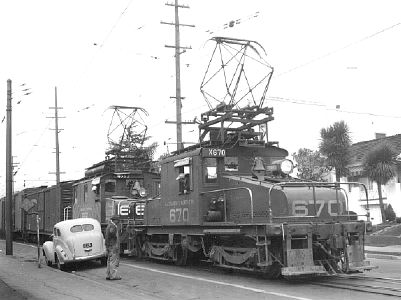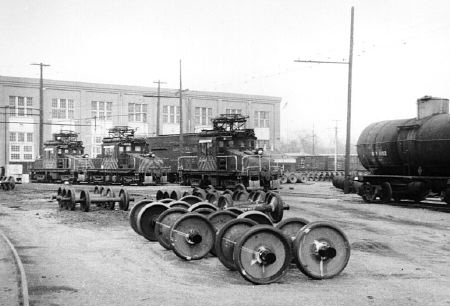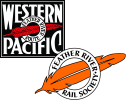GENERAL ELECTRIC STEEPLE CABS
ON THE SACRAMENTO NORTHERN
By Garth G. Groff
The 650-class General Electric steeple cab locomotives closed out electric operation on both the Sacramento Northern's Oakland-Pittsburg section and at Yuba City-Marysville. They became the most photographed and best known of all SN's cars and locomotives. The SN owned seven motors of this type, all with long and interesting service lives.
The Northern Electric Railway's Mulberry shops in Chico built most of the line's early freight motors, including a pair of steel steeple cab switchers, two more powerful steel road locomotives for heavy freight, and five composite flat-bed motors for local and switching service. The newly-renamed Sacramento Northern Railroad instead turned to outside builders in 1918. This was probably due to downsizing the shop forces after the 1914 bankruptcy, and the departure of General Manager A. D. Schindler. He had been responsible for most of the homemade locomotives, especially steeple cabs 1000 and 1001 which followed a Pacific Electric design Schindler brought from Southern California.
SNRR 1030 was the line's first locomotive from an outside builder. At 62 tons, it was a typical all-steel GE steeple cab. The locomotive was 37' 4" long over her couplers. Rolling on GE RM63B trucks, with four GE 251 motors, 1030 could produce 800 horsepower. It was designed to run on 600 volts DC, and was equipped with third rail shoes and two trolley poles. The price tag was $36,711. This locomotive was reunmbered SNRY 430 in 1928 during the "Great Merger". About this time the she received a pantograph in exchange for one of its trolley poles. The locomotive's compressors were also moved from inside the cab to below the frame. Assigned to various duties on the North End, 430 often worked at Sacramento. SN 430 ended her days switching at Marysville-Yuba City, and was sold for scrap in February 1957.

The first GE motor was apparently a success, because the SN went back for five similar locomotives over the next decade. Interestingly, in 1918 the SNRR also bought a Baldwin-Westinghouse steeple cab, 1040 (later SNRY 440). During the 1920s, the company bought four more Baldwins, ordered in pairs, and alternating with purchases from GE. Both types were used successfully for many years until dieselization during 1950s.
The next two GE locomotives were ordered in 1923, and numbered 1050 and 1051 (SNRY 650 and 651 after 1928). The price had now jumped to $42,283 each. The new locomotives were virtually identical to 430, except for having radial shank couplers which made them slightly longer at 39' 9". They rode on GE 105A trucks, and at 63 tons were just a bit heavier than 430. These locomotives were set up for both 600 and 1200 volts, foreshadowing the eventual merger with the San Francisco-Sacramento Railroad. Due to a slightly different gear ratio, they cranked out 820 horsepower from the same GE 251A motors. When the pressure on the former SF-S lines was raised to 1500 volts in 1936, these locomotives were rerated to 1000 horsepower on the South End.

Two more GE locomotives were added in 1928 at a cost of $44,752 apiece. These were originally SNRY 1052 and 1053 (soon renumbered 652 and 653). One more identical locomotive was purchased after the merger in 1930 as SN 654. This last locomotive was built in June 1928 according to GE records, but carries a March 1930 builder's plate. The SN took an option for a third locomotive on the the 1928 order. GE went ahead and built the locomotive, but the SN waited two years before taking delivery.
All the GE locomotives were originally equipped with top-running third rail shoes set up for only 600 volts. The dual voltage motors could take either 600 or 1200 (later 1500) volts through their poles and pantographs. In 1939 651 was leased to the CCT for service between Stockton and Sacramento. The locomotive was temporarily equipped with under-running third rail shoes set up for 1200 volts. During World War II, 650-654 and 660-661 were rewired to take 1500 volts from the third rail. At the request of the Army, the track near the end of Travis Army Air Force Base on the Fairfield-Suisun branch was equipped with third rail instead of overhead so low-flying aircraft would not became tangled in the wire. This was the only 1500 volt third rail on the SN system. The third rail was surplus equipment from the Key System installation on the Oakland Bay Bridge.

Most of the GE locomotives were favorites with their crews. With their auxiliary equipment mounted under the long hoods or below the frames instead of in their cabs, the GEs were much quieter than the Baldwin-Westinghouse machines. Large side windows gave the crews better visibility for switching. The short cab moved the engineer back toward the locomotive's center, giving extra protection from dangerous arcs off the third rail shoes.
The 650-class locomotives had their problems too. Their 105A trucks were smooth at high speeds, but did not equalize well when starting a train. The locomotive's weight tended to shift to one axle on each truck when starting a cut of cars, and slipping was a serious problem during switching. It took a deft hand on the controller to start a heavy train. The motors were also easy to overload, and frequently burned out their armatures in "flash-overs".
Serious wrecks on the later-day SN were rare, but 650 figured in what may have been the most unusual pile-up in the road's long history. On July 24, 1951, this locomotive was heading a 21-car train of gondolas loaded with steel for Pittsburg. The train proved too heavy for the Arcade trestle which collapsed like a row of dominos. SN 650 came to rest upright among the match wood, but her traction motors were badly damaged. When the locomotive was shopped, it received 600 volt motors. SN 650 ended her days in 1957 working around Marysville and Yuba City with 430. Technically, 650 should have been renumbered 450, but with so few electric locomotives left, there was no longer much need for separate numbers to distinguish between the 600 and 1500 volt locomotives, nor was it worth the cost of repainting.
The Tidewater Southern supplied the SN with its final GE steeple cab, the only SN electric locomotive purchased used. Originally built new for the TS in 1921 as their 106, this locomotive was mechanically a twin to the SN's 650 class. It was a 600/1500 volt unit, and was rated for 820/1000 horsepower. TS 106 used the same GE 251A motors as the 650 class, but rode on GE RM63B trucks. This locomotive was leased from the TS during the traffic surge of World War II (in exchange for the use of SN box motors 601 and 602 at Modesto). After the war, TS 106 briefly went back to Modesto, but with the end of TS electrification in 1948 it was sold outright to the SN. As 670, the locomotive was based in Oakland, and worked over the hill to West Pittsburg. SN 670 was taken out of service when ferry service ended in 1954, but was stored at Sacramento for possible later use.

Besides her trucks, 670 had several visual differences from her sisters. She had no roof air tanks, and one window on each side had been plated over by the TS. Originally built with her compressors in the cab, they were moved below the frame like the other GE machines during TS 106's leased time on the SN (which probably pleased the TS crews greatly when the locomotive came home). SN 670's controls were set up for switching rather than road use like the other GEs, the engineer's seat was backless and uncomfortable, and the RM63B trucks rode roughly at higher speeds. Most of the engineers hated this locomotive. Although she weighed about the same as the other GEs, and was rated for the same horsepower, crews claimed 670 could not pull as much as her sisters. Nobody was ever able to figure out why, and this may have been crabbing by the engineers who were hoping for another assignment.
For some unknown reason, 670 was the only one of the road's GE locomotives not repainted with orange scare stripes after the war years. She was nicknamed "The Black Widow" by the crews. Thanks to their air tanks, which reminded the crews of PT boats, the 650 class locomotives were called "Torpedoes".
In the last years of electric service between Oakland and Pittsburg, only the 650 class remained active on the South End. All of the former OA&E Baldwin-Westinghouse steeple cabs (603-606) had been scrapped. Two remaining 1500-volt Baldwins, 660-661, were in storage along with 670. When 654 toasted her 557A motors in 1956, the management considered returning 670 to service at Yuba City. Through a misunderstanding, some railfans from a well-known trolley museum had been allowed to "salvage" 670's controller and brake stand. The trainmaster probably swore a blue streak when he found the locomotive had been stripped of some of its most important equipment, though the crews were probably pleased. Instead, 670's RM63B trucks were slid under 654, and may still be seen today under this locomotive at the Western Railroad Museum. SN 670 was sold for scrap in late 1956, riding on 654's 105A trucks.
A new connection along Union Street between the Western Pacific and the Oakland Terminal Railway allowed the SN to close their troublesome Oakland operation with its stiff grades and extensive street running. The last electric train ran on a cold and rainy day, February 28, 1957. This train was carded as X652 East. With Les Paul at the controls, 652 led nine cars. SN 653, under the hand of Oscar Schindler, was pushing on the rear. When the train reached the 4% grade at Rockridge, it lost momentum and stalled because of the slippery rail. The crew had to "double" the train up to Lake Temescal. With the cars recoupled at Temescal siding, the final train resumed its climb through the Oakland Hills to Havens and disappeared into the Redwood Peak Tunnel for the last time.
It is clear from surviving correspondence that the SN would have dieselized all their lines as soon as possible, but several related factors kept the electrics running between Yuba City and Marysville after 1957. Pacific Gas and Electric Company gave the the SN a favorable rate on electric power. In addition, electric locomotives were exempt from full-crew rules, and did not need a fireman (nor did the 44-tonners, unless run as multiple units). So electric operation was a bit cheaper than with diesels, and that helped keep the motors running for a while longer.
A less well-known reason for the electrics' survival was a stiff grade east of the Yuba City yard leading up to the Feather River bridge. The pull was too much for the 44-ton diesels with any sizeable cut of cars. The little diesels were rated for a pitiful 450 tons, versus 880 tons for the electrics. SN's new 70-ton GE diesels might have handled the tonnage, but they were needed at West Sacramento for switching the new Sacto-Yolo Port and other duties. The 70-tonners also would also have required a two-man crew, making them more expensive to run than the electrics. There wasn't enough money left in the till for any additional diesels in 1957 anyway, and the WP had no diesel switchers to spare for long-term SN service. In the end, a few of the electrics received an eight-year lease on life at Yuba City purely for economic reasons.
Now on RM63B trucks, 654 became the regular switcher at Yuba City. SN 653 was the relief engine. When not in use, the extra locomotive was stored inside the WP shops in Sacramento, now safely tucked away from railfans. Hanger queen 652 was slowly stripped of parts to keep her two sisters running.

The size of freight cars grew during the early 1960s, with 70-ton cars becoming the norm. Even with lower crew and power costs, the aging electrics were no longer up to the job at Yuba City. It wasn't until 1964 that the SN could again give serious thought to replacing the electric locomotives. Over on the WP, recent purchase of GP-35s caused older road engines to be bumped down to switching service. Yard switchers at the bottom of WP's food chain were now available for duty at Yuba City, including SW-1s 501 and 502 (later SN 401-402). These diesels had no trouble with the trestle grade (though according to former engineer Tom Irion, they were SLOW!), and the electrics were soon out of work.
A farewell excursion headed by 654 on April 10, 1965, covered most of the track at Marysville and Yuba City. Then the power was turned off for the last time, ending California's electric freight railroading era. The SN management generously donated 654 and the hulk of 652 to the Bay Area Electric Railroad Association. Both may be seen at the Western Railway Museum at Rio Vista Junction. SN 654 is nicely restored and repainted. SN 652 remains a stripped shell and now lives in the museum's new Car House. It was repainted and cosmetically restored in 2005. SN 653 was donated to the Orange Empire Railway Museum at Perris.

